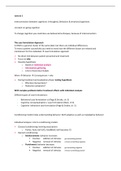College aantekeningen
Summary and notes of lectures CBT
- Instelling
- Universiteit Utrecht (UU)
Notes of the lectures of CBT, included some pictures of slides and summaries of some video's we had to watch (but not all video's). Also included a summary of article Wallace.
[Meer zien]





